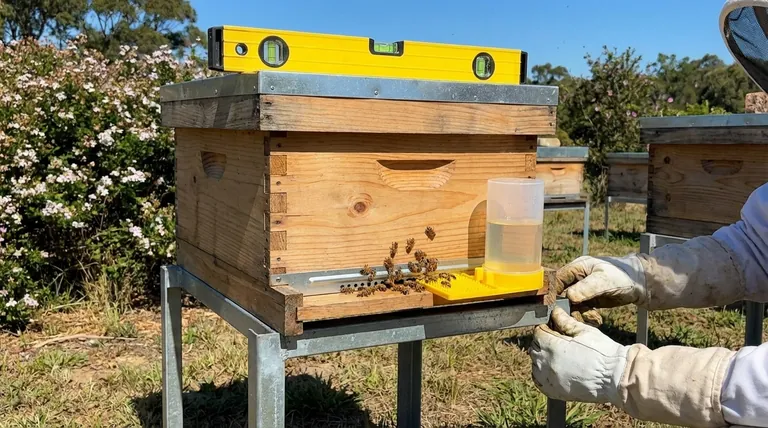To prevent syrup loss from internal feeders, you must place your hive on perfectly level ground. Even a minor tilt can cause the liquid syrup to pool on one side of the feeder, bypassing the areas where bees can access it and leaking out of the hive.
The core issue is that the design of most internal bee feeders relies on a perfectly level hive to function correctly. Any tilt disrupts the mechanics of the feeder, leading to wasted syrup, the attraction of pests, and potential harm to your bees.

The Critical Role of a Level Hive
A level hive isn't just about aesthetics; it's a functional requirement for effective feeding. Understanding why it matters is key to preventing problems before they start.
How Level Ground Ensures Proper Function
Most top feeders and frame feeders are designed like simple reservoirs. They count on gravity to distribute the syrup evenly across the bottom of the tray.
This even distribution ensures the syrup depth is consistent, allowing bees to safely access the food from designated floats, screens, or ladders without drowning.
The Consequences of an Unlevel Hive
When a hive is tilted, the syrup pools on the lower side. This creates two immediate problems.
First, the deep pool of syrup can overwhelm the feeder's safety features, creating a drowning hazard for your bees.
Second, if the syrup level on the low side rises above the feeder's edge or a seam in the hive body, it will leak out, wasting your resources and attracting ants, wasps, and other pests.
Feeder Setup and Hive Components
The reference to a "tray" and a "riser" points to specific equipment considerations that directly impact your success.
Understanding Feeder Depth
The term "shallow tray" refers to a standard top feeder. If the hive is tilted, syrup can easily spill over the low-rimmed edge of the tray.
Deeper frame feeders are more forgiving of a slight tilt, but a significant angle will still cause the same leakage and drowning issues.
The Purpose of a Riser
A riser (also known as a shim or an eke) is a simple wooden spacer, often the same dimensions as a hive box but only an inch or two tall.
Its purpose is to create a gap between the top of the frames and the inner cover. This space is necessary to accommodate a top feeder, ensuring it sits flat and has adequate clearance without crushing bees. If your feeder doesn't sit securely, a riser is essential.
Common Pitfalls to Avoid
Achieving a level setup requires attention to detail. Simply placing a hive on the ground is rarely sufficient.
Overlooking Ground Settlement
Soil, especially soft dirt or grass, will compact and settle over time under the weight of a hive. Rain can accelerate this process significantly.
A hive that was level during installation may become tilted weeks later. It is crucial to check for level periodically, especially after wet weather.
Using Unstable Foundations
Placing hives directly on the ground is not recommended. Using unstable shims like loose rocks or rotting wood can lead to shifting.
A dedicated hive stand or solid, flat paving stones provide a much more stable and reliable foundation for keeping the hive level long-term.
Making the Right Choice for Your Goal
To ensure your feeding efforts are successful, tailor your setup to your equipment and environment.
- If your primary focus is preventing leaks with any internal feeder: Your absolute priority is to use a level to ensure the hive stand and the hive itself are perfectly level in both directions (side-to-side and front-to-back).
- If your primary focus is proper equipment fit: Use a dedicated riser if your top feeder doesn't sit securely on the top bars of the frames, as this ensures the feeder itself can rest level.
- If your primary focus is long-term stability: Prepare the ground first by clearing debris and compacting the soil, then build your hive on a sturdy, dedicated stand rather than directly on the ground.
A level hive is the foundation for efficient feeding, a healthier colony, and a less wasteful beekeeping operation.
Summary Table:
| Key Consideration | Why It Matters |
|---|---|
| Level Ground | Prevents syrup from pooling and leaking out of the feeder. |
| Feeder Type | Shallow top feeders are more sensitive to tilt than deep frame feeders. |
| Use of a Riser | Creates necessary space for a top feeder to sit securely and level. |
| Stable Foundation | A dedicated hive stand prevents settling and maintains level over time. |
Stop wasting syrup and protect your investment. A level hive is the foundation of successful beekeeping. HONESTBEE supplies commercial apiaries and distributors with the durable equipment and wholesale supplies needed for a stable, productive operation. Contact our experts today to discuss your hive setup and wholesale needs.
Visual Guide

Related Products
- HONESTBEE Professional Entrance Bee Feeder Hive Nutrition Solution
- Boardman Entrance Bee Feeder Durable Galvanized Steel and Wood Construction for Beekeeping
- Professional Hive Front Entrance Bee Feeder
- Classic Boardman Entrance Bee Feeder Hive Front Feeding Solution
- In-Hive Dual Compartment Frame Bee Feeder for Targeted Colony Nutrition
People Also Ask
- How is the mesh ladder and barrier installed in the feeder box? A Step-by-Step Guide to Prevent Bee Drowning
- How to make an entrance feeder for bees? A DIY Guide for Safe & Effective Feeding
- How does the entrance feeder method work? A Guide to Simple But Risky Hive Feeding
- How do you make an entrance feeder for bees? A Guide to Safe & Effective Hive Feeding
- What types of bee feeders are available for beginners? Start with the Simple Entrance Feeder



















